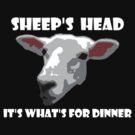US Meat Will Have to Do
I’ve been enjoying reading the news about a new program to import US and Canadian beef cattle to Kazakhstan in order to improve the stock here. One of the common stereotypes in Kazakhstan about the US is that American meat tastes awful while Kazakhstan meat is very good. Now I have a theory on this: Kazakhstani tend to eat their meat boiled, and cooked well done, whereas Americans tend to grill, fry or roast their meat and eat it a little bit pink. Americans also like their meat low-fat, whereas the average Kazakhstani enjoys fatty meat (One colleague once told me that buying meat without fat is like throwing your money into the wind). And good stew meat (for boiling) does tend to need a bit of fat. So if you boil low-fat meat (or boil a steak or something) of course it will taste bad.
But as it turns out, Kazakhstan has been facing a meat crisis for a while. And I’ve heard from sources in the Ministry of Agriculture that in fact a large percentage of meat in Kazakhstan is imported from the US. So in fact, we’ve been eating US meat for a few years now. So while I feel a bit vindicated that that Kazakhstan meat everyone praises is in fact US meat, I am glad, for the sake of ranchers, that Kazakhstan is choosing to import cows now.
This article from the Telegram, a Canadian newspaper, has way too much fun with cow puns and focuses on the airport in Canada that is acting as a half-way point. And this article from the Fort Francis local paper talks to some of the ranchers and why they are participating. Kazakhstan appears to be paying a good price to get these cattle ($1500-$1400 a head, instead of the market price of $1000-$1100), which is a good sign that this program is being well run.
But there was one interesting note:
Especially in Kazakhstan, the government’s mandate and support for importing the cattle comes, in part, as a way to increase employment.
“Depending on what time of year it is, we’ve got around 1,000 head of cattle kicking around [our ranch] (sic) and it takes one or two guys to do chores for three hours in the morning and that’s it,” [Kristi Guilford of Xports International] explained.
“Whereas over there, they’ll have 400-500 people that are there to feed their 2,000 head of cattle.”
If she’s right, Kazakhstan has a ways to go to increase its competitiveness and efficiency. 2 guys working for 3 hours to handle 1000 cattle in North America versus 400-500 people for 2000 cattle? That means the farms are seriously over-employing people (and presumably paying tiny wages or being forced to maintain a ridiculously high payroll that leaves the company unprofitable). And it likely means that management and possibly technology is not being implemented well.
And if you want to see a a great picture of the cows check out the AP article on it.










Well the Telegram certainly has their wits about them!
I can’t speak too much about the other states, but in California we have a large and extensive network to assure that the safety of the food supply. In the branch I assist with budget matters, there are programs to address:
-controlling and preventing specific diseases
-brand registration (to track animals coming in/leaving the state)
-meat inspection (for meat that goes directly to consumers)
-milk/dairy testing (for milk, milk products, and products resembling milk products)
And to assure that all the safety regulations are upheld to the highest order (as possible), we have a network of four laboratories in the UC system strategically placed thoughout the state to handle samples. Also, field staff undergo periodic training to keep their licenses as inspectors.
It’s a pretty safe bet that cows coming from the states (especially CA 🙂 ) are healthy, but ranchers tend to feed their cows in a way that maximizes profit: corn based diets instead of grain and grass which supposedly affects flavor. After they’re exported to Kazakhstan, (I’m guessing here) since corn isn’t the cash crop, they graze on a more natural diet and the beef ends up being a very high quality commodity.
[…] just posted on importing cattle to solve some of the problems of the meat industry, I was perhaps particularly attentive to meat […]
Don’t be too quick to judge efficiency of feeding systems. The US method that employs only a few people likely also uses several very expensive pieces of machinery. The many Kazakhstan feeders do the work of the expensive machinery, and may be just as financially efficient.
Quality of beef is most dependent on the nutrition of the animal. In the US much of the beef is from Holstein steers from the dairy industry. The meat is quite good due to good nutrition and health. Kazakhstan has many outstanding cattle that are every bit as good as cattle in the US and are well adapted to the local conditions, something the imported cattle may or may not easily adjust to. Certainly the cooking methods will heavily influence the taste of the beef.